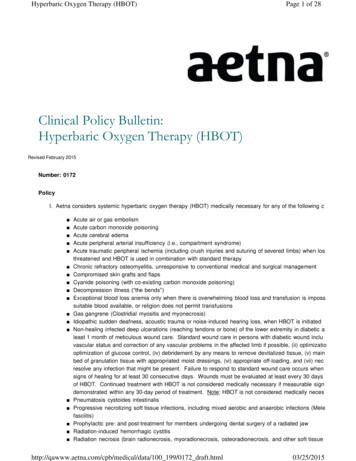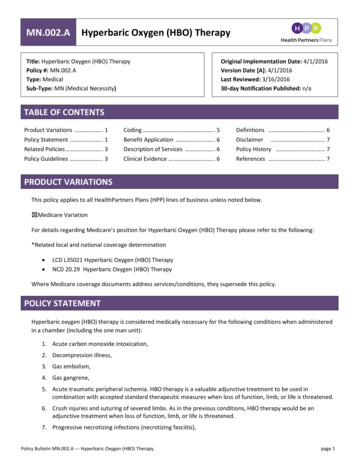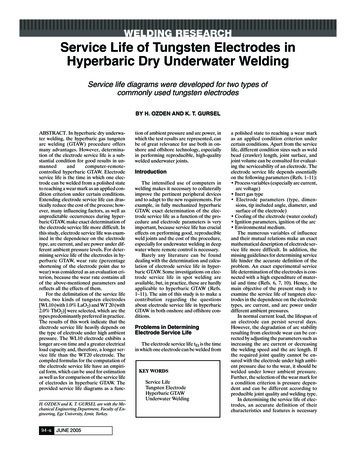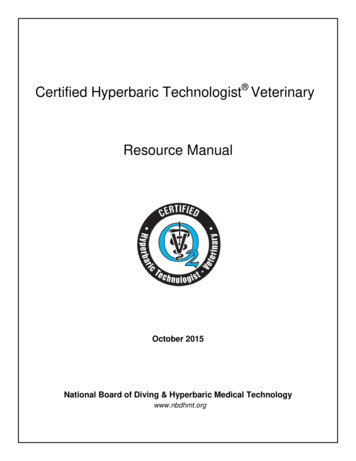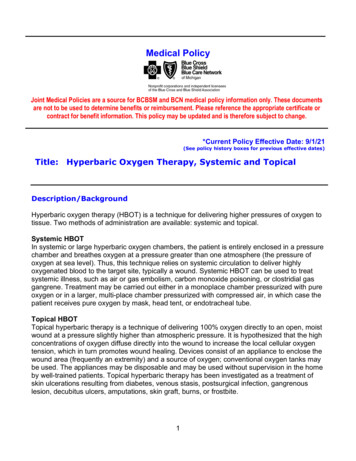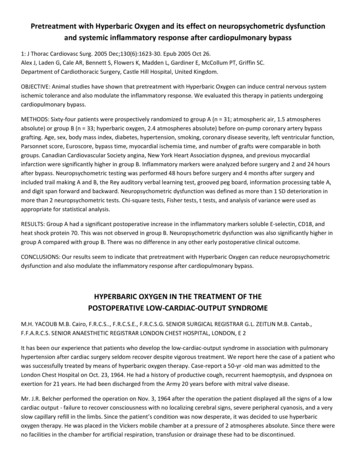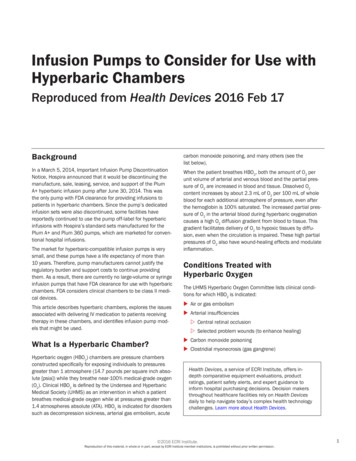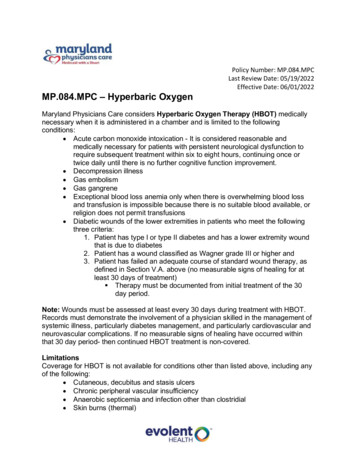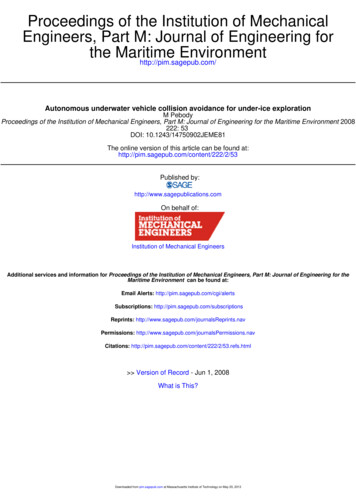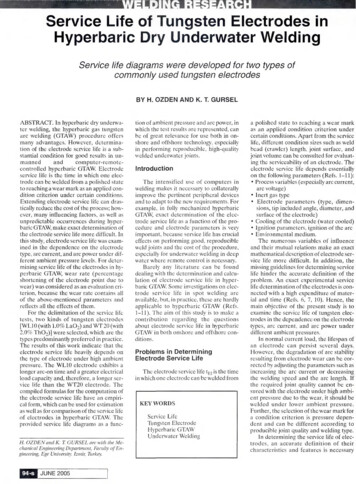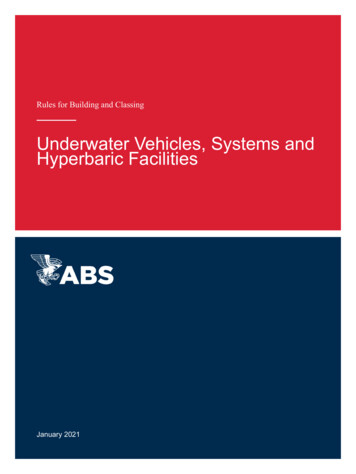
Transcription
Rules for Building and ClassingUnderwater Vehicles, Systems andHyperbaric FacilitiesJanuary 2021
RULES FOR BUILDING AND CLASSINGUNDERWATER VEHICLES, SYSTEMS AND HYPERBARICFACILITIESJANUARY 2021American Bureau of ShippingIncorporated by Act of Legislature ofthe State of New York 1862 2021 American Bureau of Shipping. All rights reserved.ABS Plaza1701 City Plaza DriveSpring, TX 77389 USA
Foreword (2021)The 2021 edition of the Rules for Building and Classing Underwater Vehicles, Systems and HyperbaricFacilities incorporates all Rule Changes and Corrigenda items since 2020. Requirements for underwaterhabitats and complexes have been added. Sections 1 through 10 provide the general requirements that are applicable to all categories ofunderwater vehicles, systems and hyperbaric facilities. Section 11 provides the specific requirements that are applicable to manned submersibles. Section 12 provides the specific requirements that are applicable to lock-out submersibles. Section 13 provides the specific requirements that are applicable to ambient pressure submersibles. Section 14 provides the specific requirements that are applicable to diving systems. Section 15 provides the specific requirements that are applicable to Hyperbaric Facilities. Section 16 provides the specific requirements that are applicable to atmospheric diving suits. Section 17 provides the specific requirements that are applicable to underwater habitats andcomplexes. Section 18 provides the specific requirements that are applicable to remotely operated vehicles. Section 19 provides the specific requirements that are applicable to autonomous underwater vehicles. Section20 provides the specific requirements that are applicable to handling systems. Section 21 provides the specific requirements that are applicable to dive control stations. Section 22 provides the requirements for surveys after construction. Appendix 1 provides relevant excerpts from IMO Res. A.831 (19) Code of Safety for Diving Systemsregarding diving bell emergency locating devicesThe effective date of each technical change is shown in parentheses at the end of the subsection/paragraphtitles within the text of each Section. Unless a particular date and month are shown, the effective date is 1January of the year shown.ABS RULES FOR BUILDING AND CLASSING UNDERWATER VEHICLES, SYSTEMS AND HYPERBARICFACILITIES 2021ii
RULES FOR BUILDING AND CLASSINGUNDERWATER VEHICLES, SYSTEMS AND HYPERBARICFACILITIESCONTENTSSECTION1Scope and Conditions of Classification. 25SECTION2Definitions (2016). 261Chamber Gas Reclaim System (2013). 263Clinical Hyperbaric Treatment Chamber.265Command Compartment (2012). 267Deck Decompression Chamber.269Design Depth. 2611Design Pressure (2013) .2613Design Mission Time.2615Dive Control Station (2013). 2617Diver Gas Reclaim System (2013). 2719Diver Lock-out Compartment.2721Diver Training Hyperbaric Center. 2723Diving Bell.2724Hyperbaric Diving Simulator. 2725Diving System.2727Fire-restricting Materials (2002).2729Fixed Diving System (F) (2012). 2731Gas Reclaim System (2013).2733Underwater Habitat.2735Handling System.2837Hyperbaric Evacuation System (2010). 2839Hyperbaric Evacuation Unit (2010).2841Hyperbaric Facility. 2842Hyperbaric Reception Facility (HRF). 2843Launch and Recovery System (2011).2845Light Ship (2002). 2847Lock-Out Submersible (2012).2849Manipulator. 28ABS RULES FOR BUILDING AND CLASSING UNDERWATER VEHICLES, SYSTEMS AND HYPERBARICFACILITIES 2021iii
5153No-Decompression Limit (2011). 29Open Bell. enger Submersible (2013). 29Personnel Capsule. 29Portable Decompression Chamber.29Portable Diving System (P) (2012). 29Pressure Boundary (2013).29Pressure Hull (2011). 29Pressure Resistant (2013). 29Pressure Vessel for Human Occupancy (PVHO) (2013). 29Rated Depth.29Rated Internal Pressure.30Remotely Operated Vehicle. 30ROV. 30Submersible.30Submersible Decompression Chamber. 30Tethered Submersible.30Umbilical. 30Underwater Complex. 30Underwater Container.30Underwater System. 30Underwater Vehicle.30Unit (2007). 30Working Chamber.31SECTION3General Requirements and Safeguards .321Nonmetallic Materials. 321.1General. 321.3Paints, Varnishes and Coatings (2007). 321.5Internal Materials (2007).321.7External Materials (2002).323Protection.325Corrosion Protection (2007).327Thermal Protection (2007). 33SECTION4Materials. 341General. 343Pressure Boundary Material Specifications. 343.1Plates (2010). 343.3Bolts, Extrusions, Forgings, and Shapes.343.5Materials Complying with Other Standards. 345Testing. 345.1Inspection. 35ABS RULES FOR BUILDING AND CLASSING UNDERWATER VEHICLES, SYSTEMS AND HYPERBARICFACILITIES 2021iv
75.3Toughness Testing. 35Corrosion and Galvanic Action. 367.17.3TABLE 1SECTION5Ferritic Materials. 36Galvanic Action.36Charpy Impact Testing Requirements. 35Fabrication.371Material Identification.373Alignment Tolerance. 373.1Butt Weld Alignment. 373.3Heads and Spherical Vessels. 375Joints. 385.1Category A and B. 385.3Category C and D. 385.5Joint Properties.387Welding of Ferrous Materials.387.1General. 387.3Qualifications and Procedures.387.5Special Tests.397.7Weld Metal Impact Properties.397.9Weld Metal Tensile Strength. 397.11Postweld Heat Treatment (2014). 397.13Production Testing. 407.15Nondestructive Examinations. 407.17Weld Repairs. 429Welding of Non-Ferrous Materials (2002).429.1General. 429.3Welded Joints in Aluminum. 4211Out-of-Roundness, Sphericity and Local Departure fromDesign Geometry.4211.1Measurements (2015).4211.3Permitted Deviations of Cylinders and ConicalSections. 4211.5Permitted Deviations of Spheres and Hemispheres. 4311.7Thickness.4411.9Location of Measurements. 4413Surface Finish.44FIGURE 1FIGURE 2FIGURE 3Illustration of Welded Joint LocationsTypical ofCategories A, B, C and D.45Maximum Permissible Deviation from Circular Form“e”for Vessels Under External Pressure.46Arc Length.46ABS RULES FOR BUILDING AND CLASSING UNDERWATER VEHICLES, SYSTEMS AND HYPERBARICFACILITIES 2021v
FIGURE 4SECTION6Values of Chord Length (Lc) for Out-of-roundness ofSpheres.47Metallic Pressure Boundary Components.481General. 483Design for Internal Pressure (2010).485Design Pressures and Loads (2010). 485.1General. 485.3Localized Loads.487Reinforcement. 499Fatigue (2002). 4911Drainage (2002).5013Corrosion Allowance.5015Definition and Determination of Yield Point and Yield Strength.5015.1Yield Point.5015.3Yield Strength. 5017Nomenclature. 5017.1General. 5017.3Material Properties.5017.5Calculated External Pressures. 5017.7Shell Parameters. 5119Cylindrical Shells Under External Pressure. 5119.1Shell Geometry. 5119.3Stiffener Properties. 5219.5Inter-Stiffener Strength. 5219.7Unstiffened Cylinders.5319.9Length Between Support Members. 5319.11 Heavy Stiffeners. 5319.13 Overall Buckling Strength. 5319.15 Stiffeners.5321Conical Shells Under External Pressure.5621.1Shell Geometry. 5621.3Stiffener Properties (See Notes in 6/21.7 and 6/21.15). 5621.5General. 5621.7Inter-Stiffener Strength. 5621.9Unstiffened Cones. 5821.11 Length between Support Members.5821.13 Heavy Stiffeners. 5821.15 Overall Buckling Strength. 5821.17 Stiffeners.5923Spherical Shells Under External Pressure.6223.1Shell Geometry. 6223.3General. 6223.5Hemispherical Dished Heads. 62ABS RULES FOR BUILDING AND CLASSING UNDERWATER VEHICLES, SYSTEMS AND HYPERBARICFACILITIES 2021vi
23.723.9252723.11 Shape Limitations. 63Fasteners (2013). 63Proof Testing (2015). 6327.1Hydrostatic Test. 6327.3Strain Gauging.6427.5Waiver of Strain Gauging.6427.7Post Test Examination. 6427.9Alternate Test Procedures. 64FIGURE 1FIGURE 2FIGURE 3FIGURE 4FIGURE 5FIGURE 6SECTION7Ellipsoidal Heads. 62Torispherical Heads. 63Illustrative Hull Components. 64Definitions –Compartment Length.65Definitions. 65Overall Buckling Strength –Lobes Expected at Failure.66Definitions –Cones. 67Definitions –Heads. 68Windows and Viewports.691General. 691.1.691.3.693Definitions (2010).693.1Design Life.693.3Service Life. 693.5Service Cycle.693.7Viewport Assembly. 693.9Window. 695Submission of Drawings and Data.707Design Parameters and Operating Conditions (2009).709Certification (2009). 709.1Design Certification.709.3Material Manufacturer’s Certification. 709.5Material Testing Certification.709.7Pressure Testing Certification. 709.9Fabrication Certification. 7111Viewport Flanges. 7113Dimensional Tolerances.7115Window Fabrication. 7115.1.7115.3.7115.5.7115.7.71ABS RULES FOR BUILDING AND CLASSING UNDERWATER VEHICLES, SYSTEMS AND HYPERBARICFACILITIES 2021vii
17192123SECTION8Installation of Windows. 7117.1.7117.3.7117.5.72Pressure Testing (2009).7219.1.7219.3.7219.5.7219.7.7219.9.7219.11 .7219.13 (2009). 72Marking. 73Window Repairs.73Life Support and Environmental Control Systems.741General. 743Plans and Data to be Submitted. 745Design Principles. 745.1Definitions (2010).745.3General (2012).755.5Standard Person (2013). 755.7Fire Hazard (2007).757Breathing Gas.757.1Oxygen Supply (2009). 757.3Closed Breathing Gas Circuits.757.5Breathing Gas Storage. 757.7Fresh Air (2010).769Carbon Dioxide (CO2) Removal Systems. 769.1Capacity (2013). 769.3Expendable Methods. 769.5Regenerable Reagents.769.7Other Means of CO2 Removal. 769.9Materials. 769.11Canister Replacement. 7611Life Support Piping (2017). 7711.1Materials. 7711.3Fittings. 7811.5Valves. 7911.7Piping/Tubing. 7911.9Oxygen Piping/Tubing.8011.11 Hoses.8011.13 Umbilicals. 81ABS RULES FOR BUILDING AND CLASSING UNDERWATER VEHICLES, SYSTEMS AND HYPERBARICFACILITIES 2021viii
13151719212325272911.15 Color Coding.81Life Support Instrumentation.8113.1Monitored Parameters (2012).8113.3Monitoring Equipment (2007). 8113.5Display Locations (2012). 82Controls. 8215.1General. 8215.3Manual Controls.8215.5Automatic Controls. 82Diving Temperature and Humidity Controls. 8217.1Heating and Cooling. 8217.3Humidity.8217.5Electric Water Heaters. 8217.7Air Conditioning. 82Cleaning (2013). 83Filtration Systems. 83Air Compressors (2013).83Mercury.83Gas Reclaim Systems (2012). 8327.1Monitored Parameters. 8327.3Diver Gas Reclaim Systems. 83Testing (2013). 8529.1Breathing Gas Piping Systems. 8529.3Pressure Vessels for Human Occupancy andPressure Hulls. 8529.5Leak Testing.8829.7Life Support Testing. 88TABLE 1TABLE 2SECTION9Monochloro/Dichloroacetylene Precursor Compounds(2018).86Conversion Factor (Fp) (2013).87Piping Systems and Mechanical Equipment.891General. 893Production Equipment. 895Pressure Vessels, Heat Exchangers and Heaters.895.1General (2002).895.3Pressure Vessels Subject to External Pressure (2002). 905.5Pressure Vessel Location. 905.7Safety Relief Devices (2010). 907Piping Systems. 917.1General. 917.3Wall Thickness of Pipes and Tubes.91ABS RULES FOR BUILDING AND CLASSING UNDERWATER VEHICLES, SYSTEMS AND HYPERBARICFACILITIES 2021ix
7.59111315177.7Piping Systems Penetrating the Pressure Boundary.917.9.927.11.927.13(2010). 927.15(2002). 927.17.937.19.937.21.937.23(2007). 93Color-coding and Labeling.939.1.939.3.94Radiographic Examination of Welded Piping Connections.94Pumps and Compressors. 94Air Conditioning System (2007). 94Equipment.94TABLE 1SECTIONWall Thickness of Pipes and Tubes Subject toExternal Pressure. 91Color Codes for Piping and Gas Storage Bottles.9310 Electrical Systems. 951General. 953Application. 953.1Environment.953.3Pressurization. 953.5Hazardous Areas. 953.7Underwater Electrical Equipment. 953.9Humidity (2007). 955Power.955.1Main and Emergency Power (2002). 955.3Power Source. 965.5Power Source Separation.965.7Automatic Emergency Power Changeover.965.9Equipment on Emergency Power. 965.11Sizing of Emergency Source. 967Voltage.
Facilities incorporates all Rule Changes and Corrigenda items since 2020. Requirements for underwater habitats and complexes have been added. Sections 1 through 10 provide the general requirements that are applicable to all categories of underwater vehicles, systems and hyperbaric facilities.
